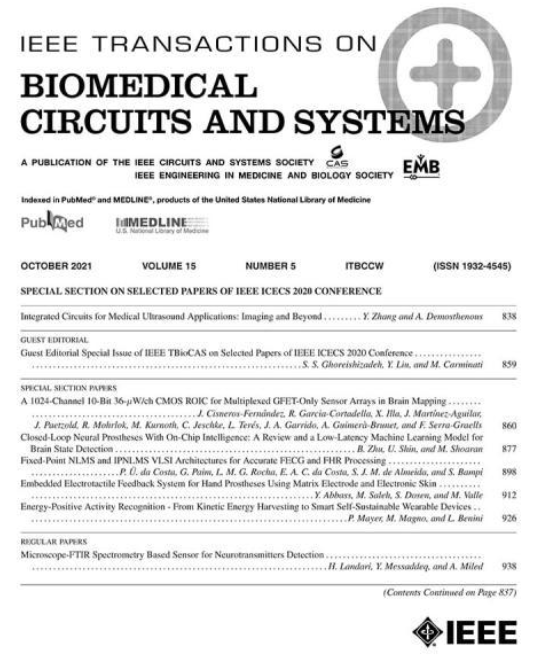Smart Multi-Frequency Bioelectrical Impedance Spectrometer for BIA and BIVA Applications
IF 4.9
2区 医学
Q2 ENGINEERING, BIOMEDICAL
IEEE Transactions on Biomedical Circuits and Systems
Pub Date : 2016-02-03
DOI:10.1109/TBCAS.2015.2502538
引用次数: 28
Abstract
Bioelectrical impedance analysis (BIA) is a noninvasive and commonly used method for the assessment of body composition including body water. We designed a small, portable and wireless multi-frequency impedance spectrometer based on the 12 bit impedance network analyzer AD5933 and a precision wide-band constant current source for tetrapolar whole body impedance measurements. The impedance spectrometer communicates via Bluetooth with mobile devices (smart phone or tablet computer) that provide user interface for patient management and data visualization. The export of patient measurement results into a clinical research database facilitates the aggregation of bioelectrical impedance analysis and biolectrical impedance vector analysis (BIVA) data across multiple subjects and/or studies. The performance of the spectrometer was evaluated using a passive tissue equivalent circuit model as well as a comparison of body composition changes assessed with bioelectrical impedance and dual-energy X-ray absorptiometry (DXA) in healthy volunteers. Our results show an absolute error of 1% for resistance and 5% for reactance measurements in the frequency range of 3 kHz to 150 kHz. A linear regression of BIA and DXA fat mass estimations showed a strong correlation (r2=0.985) between measures with a maximum absolute error of 6.5%. The simplicity of BIA measurements, a cost effective design and the simple visual representation of impedance data enables patients to compare and determine body composition during the time course of a specific treatment plan in a clinical or home environment.用于BIA和BIVA应用的智能多频生物电阻抗光谱仪
生物电阻抗分析(BIA)是一种无创的、常用的身体成分评估方法。基于12位阻抗网络分析仪AD5933和精密宽带恒流源,设计了一种小型便携式无线多频阻抗谱仪,用于四极体全身阻抗测量。阻抗谱仪通过蓝牙与移动设备(智能手机或平板电脑)通信,为患者管理和数据可视化提供用户界面。将患者测量结果导出到临床研究数据库有助于跨多个主题和/或研究汇总生物电阻抗分析和生物电阻抗矢量分析(BIVA)数据。使用无源组织等效电路模型评估光谱仪的性能,并比较健康志愿者的生物电阻抗和双能x射线吸收仪(DXA)评估的身体成分变化。我们的结果表明,在3 kHz至150 kHz频率范围内,电阻测量的绝对误差为1%,电抗测量的绝对误差为5%。BIA和DXA脂肪质量估计的线性回归表明,测量之间的相关性很强(r2=0.985),最大绝对误差为6.5%。BIA测量的简单性,具有成本效益的设计和阻抗数据的简单可视化表示使患者能够在临床或家庭环境中进行特定治疗计划的时间过程中比较和确定身体成分。
本文章由计算机程序翻译,如有差异,请以英文原文为准。
求助全文
约1分钟内获得全文
求助全文
来源期刊

IEEE Transactions on Biomedical Circuits and Systems
工程技术-工程:电子与电气
CiteScore
10.00
自引率
13.70%
发文量
174
审稿时长
3 months
期刊介绍:
The IEEE Transactions on Biomedical Circuits and Systems addresses areas at the crossroads of Circuits and Systems and Life Sciences. The main emphasis is on microelectronic issues in a wide range of applications found in life sciences, physical sciences and engineering. The primary goal of the journal is to bridge the unique scientific and technical activities of the Circuits and Systems Society to a wide variety of related areas such as: • Bioelectronics • Implantable and wearable electronics like cochlear and retinal prosthesis, motor control, etc. • Biotechnology sensor circuits, integrated systems, and networks • Micropower imaging technology • BioMEMS • Lab-on-chip Bio-nanotechnology • Organic Semiconductors • Biomedical Engineering • Genomics and Proteomics • Neuromorphic Engineering • Smart sensors • Low power micro- and nanoelectronics • Mixed-mode system-on-chip • Wireless technology • Gene circuits and molecular circuits • System biology • Brain science and engineering: such as neuro-informatics, neural prosthesis, cognitive engineering, brain computer interface • Healthcare: information technology for biomedical, epidemiology, and other related life science applications. General, theoretical, and application-oriented papers in the abovementioned technical areas with a Circuits and Systems perspective are encouraged to publish in TBioCAS. Of special interest are biomedical-oriented papers with a Circuits and Systems angle.
 求助内容:
求助内容: 应助结果提醒方式:
应助结果提醒方式:


